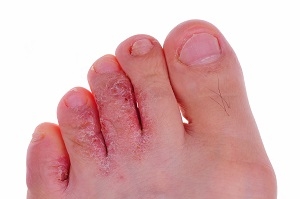Athlete’s Foot

Athletes Foot is a skin infection caused by a fungus, found usually on the feet. Fungi are common germs often found in small numbers on human skin where they usually do no harm. However, given the right conditions fungi multiply and invade the skin causing infection. Fungi enjoy a warm, moist and airless environment such as between the toes.
Anyone can get athletes foot, it can also be passed from person to person. For example, at swimming baths a tiny flake of infected skin from a person with athlete’s foot can fall off and may be trodden on by others who in turn can develop the infection. Once a small patch of infection develops, it typically spreads along the skin infecting all toes.
The skin between the toes is usually infected first. It starts with an itchy scaly rash. The skin may become cracked and sore. Tiny flakes of infected skin may fall off. The rash can spread quite rapidly along the toes and if left untreated can spread to the sole and sides of the foot.
Treatment:
Antifungal cream bought from the chemist or on prescription is the usual method of treatment. There are various types and brands. The instructions for purchased or prescribed cream treatments are usually given in the enclosed leaflet. However, it is usual to apply cream to the affected area including the surrounding normal skin. Although the rash may appear to subside quite quickly it is recommended that treatment continues for at least 1-2 weeks after the rash has gone to prevent rash from returning. If the skin is particularly enflamed it may be necessary to see a doctor who may prescribe an anti fungal cream combined with a mild steroid cream. Steroid cream alone however will not treat the infection. Sometimes an anti fungal tablet is prescribed in circumstances where the infection has not responded well to creams alone or if the infection is particularly severe.
There is no need to avoid work or school etc; so long as the feet are covered in communal changing areas until the rash has gone.
Serious cases:
It is worth mentioning that although athlete’s foot is not a serious condition it is important that treatment is sought. Sometimes the infection can spread to skin on other parts of the body. These are usually moist and airless parts of the skin such as the groin. Fungi infections do not usually go deeper than the skin into the body. However, other germs (bacterial) may enter through cracked skin or untreated athlete’s foot. This can occasionally lead to more serious infections of the foot or leg such as cellulites.
- Wash and dry feet and toes daily
- Dry the skin between toes after washing thoroughly. This is perhaps the most important point as soggy skin is ideal for fungi to grow.
- Do not share towels
- Change socks daily, fungi multiply in flakes of skin in unwashed socks. Cotton socks and leather footwear are better than nylon socks and plastic shoes.
- Try to alternate between shoes every 2-3 days to allow the shoes to dry out fully.
- Wear flip flops in communal showering areas to avoid walking around barefoot.
- When at home wherever possible and if you are able leave shoes and socks off to let as much air get to your feet.
All information on this website is for general guidance only and is not intended as a substitute for the personal medical advice of health care professionals or your own doctor.
